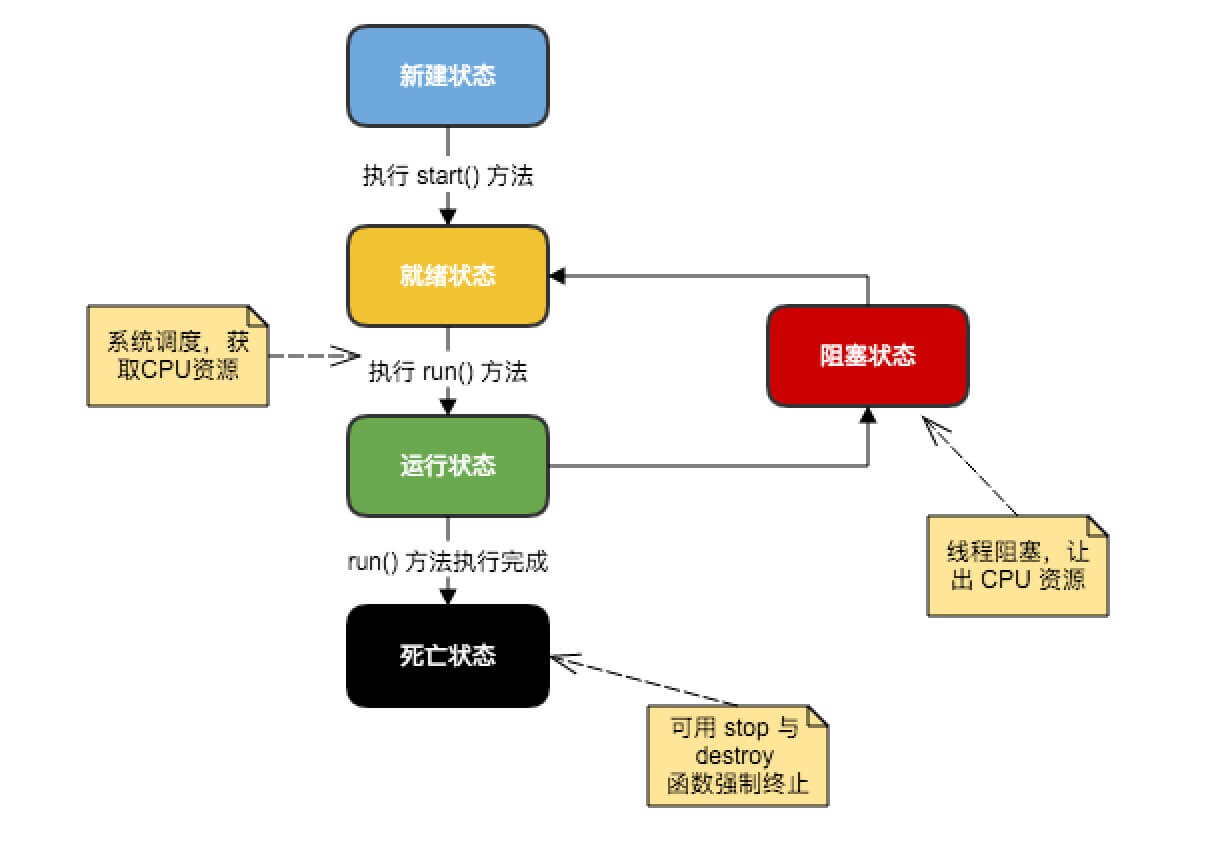日期:2020-12-04 10:33作者:北大青鸟西安华清校区
Java给多线程编程提供了内置的支持。一个多线程程序包含两个或多个能并发运行的部分。程序的每一部分都称作一个线程,并且每个线程定义了一个独立的执行路径。
多线程是多任务的一种特别的形式。多线程比多任务需要更小的开销。
这里定义和线程相关的另一个术语:进程:一个进程包括由操作系统分配的内存空间,包含一个或多个线程。一个线程不能独立的存在,它必须是进程的一部分。一个进程一直运行,直到所有的非守候线程都结束运行后才能结束。
多线程能满足程序员编写非常有效率的程序来达到充分利用CPU的目的,因为CPU的空闲时间能够保持在最低限度。
线程经过其生命周期的各个阶段。下图显示了一个线程完整的生命周期。

新建状态: 一个新产生的线程从新状态开始了它的生命周期。它保持这个状态直到程序start这个线程。
运行状态:当一个新状态的线程被start以后,线程就变成可运行状态,一个线程在此状态下被认为是开始执行其任务
就绪状态:当一个线程等待另外一个线程执行一个任务的时候,该线程就进入就绪状态。当另一个线程给就绪状态的线程发送信号时,该线程才重新切换到运行状态。
休眠状态: 由于一个线程的时间片用完了,该线程从运行状态进入休眠状态。当时间间隔到期或者等待的事件发生了,该状态的线程切换到运行状态。
终止状态: 一个运行状态的线程完成任务或者其他终止条件发生,该线程就切换到终止状态。
每一个Java线程都有一个优先级,这样有助于操作系统确定线程的调度顺序。Java优先级在MIN_PRIORITY(1)和MAX_PRIORITY(10)之间的范围内。默认情况下,每一个线程都会分配一个优先级NORM_PRIORITY(5)。
具有较高优先级的线程对程序更重要,并且应该在低优先级的线程之前分配处理器时间。然而,线程优先级不能保证线程执行的顺序,而且非常依赖于平台。
Java提供了三种创建线程方法:
通过实现Runnable接口;
通过继承Thread类本身;
通过 Callable 和 Future 创建线程。
创建一个线程,最简单的方法是创建一个实现Runnable接口的类。
为了实现Runnable,一个类只需要执行一个方法调用run(),声明如下:
public void run()
你可以重写该方法,重要的是理解的run()可以调用其他方法,使用其他类,并声明变量,就像主线程一样。
在创建一个实现Runnable接口的类之后,你可以在类中实例化一个线程对象。
Thread定义了几个构造方法,下面的这个是我们经常使用的:
Thread(Runnable threadOb,String threadName);
这里,threadOb 是一个实现Runnable 接口的类的实例,并且 threadName指定新线程的名字。
新线程创建之后,你调用它的start()方法它才会运行。
void start();
下面是一个创建线程并开始让它执行的实例:
// 创建一个新的线程
class NewThread implements Runnable {
Thread t;
NewThread() {
// 创建第二个新线程
t = new Thread(this, "Demo Thread");
System.out.println("Child thread: " + t);
t.start(); // 开始线程
}
// 第二个线程入口
public void run() {
try {
for(int i = 5; i > 0; i--) {
System.out.println("Child Thread: " + i);
// 暂停线程
Thread.sleep(50);
}
} catch (InterruptedException e) {
System.out.println("Child interrupted.");
}
System.out.println("Exiting child thread.");
}
}
public class ThreadDemo {
public static void main(String args[]) {
new NewThread(); // 创建一个新线程
try {
for(int i = 5; i > 0; i--) {
System.out.println("Main Thread: " + i);
Thread.sleep(100);
}
} catch (InterruptedException e) {
System.out.println("Main thread interrupted.");
}
System.out.println("Main thread exiting.");
}
}
编译以上程序运行结果如下:
Child thread: Thread[Demo Thread,5,main]
Main Thread: 5
Child Thread: 5
Child Thread: 4
Main Thread: 4
Child Thread: 3
Child Thread: 2
Main Thread: 3
Child Thread: 1
Exiting child thread.
Main Thread: 2
Main Thread: 1
Main thread exiting.
创建一个线程的第二种方法是创建一个新的类,该类继承Thread类,然后创建一个该类的实例。
继承类必须重写run()方法,该方法是新线程的入口点。它也必须调用start()方法才能执行。该方法尽管被列为一种多线程实现方式,但是本质上也是实现了 Runnable 接口的一个实例。
// 通过继承 Thread 创建线程
class NewThread extends Thread {
NewThread() {
// 创建第二个新线程
super("Demo Thread");
System.out.println("Child thread: " + this);
start(); // 开始线程
}
// 第二个线程入口
public void run() {
try {
for(int i = 5; i > 0; i--) {
System.out.println("Child Thread: " + i);
// 让线程休眠一会
Thread.sleep(50);
}
} catch (InterruptedException e) {
System.out.println("Child interrupted.");
}
System.out.println("Exiting child thread.");
}
}
public class ExtendThread {
public static void main(String args[]) {
new NewThread(); // 创建一个新线程
try {
for(int i = 5; i > 0; i--) {
System.out.println("Main Thread: " + i);
Thread.sleep(100);
}
} catch (InterruptedException e) {
System.out.println("Main thread interrupted.");
}
System.out.println("Main thread exiting.");
}
}
编译以上程序运行结果如下:
Child thread: Thread[Demo Thread,5,main]
Main Thread: 5
Child Thread: 5
Child Thread: 4
Main Thread: 4
Child Thread: 3
Child Thread: 2
Main Thread: 3
Child Thread: 1
Exiting child thread.
Main Thread: 2
Main Thread: 1
Main thread exiting.
下表列出了Thread类的一些重要方法:
| 序号 | 方法描述 |
|---|---|
| 1 |
public void start() 使该线程开始执行;Java 虚拟机调用该线程的 run 方法。 |
| 2 |
public void run() 如果该线程是使用独立的 Runnable 运行对象构造的,则调用该 Runnable 对象的 run 方法;否则,该方法不执行任何操作并返回。 |
| 3 |
public final void setName(String name) 改变线程名称,使之与参数 name 相同。 |
| 4 |
public final void setPriority(int priority) 更改线程的优先级。 |
| 5 |
public final void setDaemon(boolean on) 将该线程标记为守护线程或用户线程。 |
| 6 |
public final void join(long millisec) 等待该线程终止的时间最长为 millis 毫秒。 |
| 7 |
public void interrupt() 中断线程。 |
| 8 |
public final boolean isAlive() 测试线程是否处于活动状态。 |
测试线程是否处于活动状态。 上述方法是被Thread对象调用的。下面的方法是Thread类的静态方法。
| 序号 | 方法描述 |
|---|---|
| 1 |
public static void yield() 暂停当前正在执行的线程对象,并执行其他线程。 |
| 2 |
public static void sleep(long millisec) 在指定的毫秒数内让当前正在执行的线程休眠(暂停执行),此操作受到系统计时器和调度程序精度和准确性的影响。 |
| 3 |
public static boolean holdsLock(Object x) 当且仅当当前线程在指定的对象上保持监视器锁时,才返回 true。 |
| 4 |
public static Thread currentThread() 返回对当前正在执行的线程对象的引用。 |
| 5 |
public static void dumpStack() 将当前线程的堆栈跟踪打印至标准错误流。 |
如下的ThreadClassDemo 程序演示了Thread类的一些方法:
// 文件名 : DisplayMessage.java
// 通过实现 Runnable 接口创建线程
public class DisplayMessage implements Runnable
{
private String message;
public DisplayMessage(String message)
{
this.message = message;
}
public void run()
{
while(true)
{
System.out.println(message);
}
}
}
GuessANumber.java 文件代码:
// 文件名 : GuessANumber.java
// 通过继承 Thread 类创建线程
public class GuessANumber extends Thread
{
private int number;
public GuessANumber(int number)
{
this.number = number;
}
public void run()
{
int counter = 0;
int guess = 0;
do
{
guess = (int) (Math.random() * 100 + 1);
System.out.println(this.getName()
+ " guesses " + guess);
counter++;
}while(guess != number);
System.out.println("** Correct! " + this.getName()
+ " in " + counter + " guesses.**");
}
}
ThreadClassDemo.java 文件代码:
// 文件名 : ThreadClassDemo.java
public class ThreadClassDemo
{
public static void main(String [] args)
{
Runnable hello = new DisplayMessage("Hello");
Thread thread1 = new Thread(hello);
thread1.setDaemon(true);
thread1.setName("hello");
System.out.println("Starting hello thread...");
thread1.start();
Runnable bye = new DisplayMessage("Goodbye");
Thread thread2 = new Thread(bye);
thread2.setPriority(Thread.MIN_PRIORITY);
thread2.setDaemon(true);
System.out.println("Starting goodbye thread...");
thread2.start();
System.out.println("Starting thread3...");
Thread thread3 = new GuessANumber(27);
thread3.start();
try
{
thread3.join();
}catch(InterruptedException e)
{
System.out.println("Thread interrupted.");
}
System.out.println("Starting thread4...");
Thread thread4 = new GuessANumber(75);
thread4.start();
System.out.println("main() is ending...");
}
}
运行结果如下,每一次运行的结果都不一样。
Starting hello thread...
Starting goodbye thread...
Hello
Hello
Hello
Hello
Hello
Hello
Hello
Hello
Hello
Starting thread3...
Hello
Hello
Starting thread4...
Hello
Hello
main() is ending...
实例
public class CallableThreadTest implements Callable<Integer> {
public static void main(String[] args)
{
CallableThreadTest ctt = new CallableThreadTest();
FutureTask<Integer> ft = new FutureTask<>(ctt);
for(int i = 0;i < 100;i++)
{
System.out.println(Thread.currentThread().getName()+" 的循环变量i的值"+i);
if(i==20)
{
new Thread(ft,"有返回值的线程").start();
}
}
try
{
System.out.println("子线程的返回值:"+ft.get());
} catch (InterruptedException e)
{
e.printStackTrace();
} catch (ExecutionException e)
{
e.printStackTrace();
}
}
@Override
public Integer call() throws Exception
{
int i = 0;
for(;i<100;i++)
{
System.out.println(Thread.currentThread().getName()+" "+i);
}
return i;
}
}
在多线程编程时,你需要了解以下几个概念:
线程同步
线程间通信
线程死锁
线程控制:挂起、停止和恢复
有效利用多线程的关键是理解程序是并发执行而不是串行执行的。例如:程序中有两个子系统需要并发执行,这时候就需要利用多线程编程。
通过对多线程的使用,可以编写出非常高效的程序。不过请注意,如果你创建太多的线程,程序执行的效率实际上是降低了,而不是提升了。
请记住,上下文的切换开销也很重要,如果你创建了太多的线程,CPU花费在上下文的切换的时间将多于执行程序的时间!